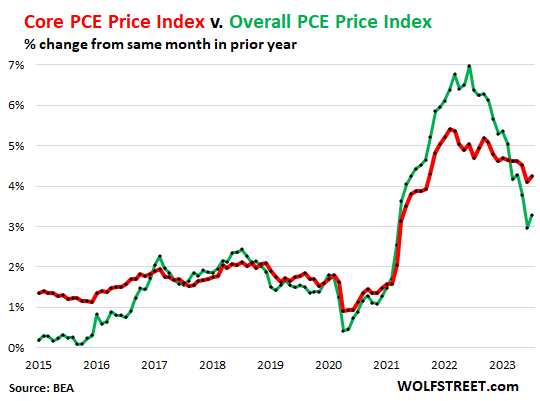Yves here. While many eyes in investing and econ-land are on the Fed’s annual Jackson Hole conference, data keeps chugging in on the state of the economy. As Angry Bear and others point out that initial jobless claims suggest that unemployment will rise (as in Fed efforts to whack labor are starting to have an effect), Wolf Richter describes below how inflation is proving to be, erm, resilient. We mentioned that the Fed and the Biden Administration seems to be giving themselves undue credit for the way the fall in energy prices since summer-early fall 2022 has blunted inflation. That decline instead seems to be due significantly to Russian energy finding its way to advanced economies via various work-arounds and the Chinese economy being weaker after the end of its zero-Covid policies than was widely expected.
In other words, the latest data keep confirming that this inflation is to a very large degree driven by supply issues largely outside the Fed’s control, and not due to labor having excessive bargaining pawer and labor costs and high consumer demand driving up prices.
By Wolf Richter, editor of Wolf Street. Originally published at Wolf Street
Services inflation is at it again. Year-over-year, the “core services” PCE price index accelerated to 5.4%, the second worst since 1985, according to data by the Bureau of Economic Analysis today, sharing that spot with January 2023. February had been the worst.
The Fed’s job is far from done. Powell has been fretting about core services inflation for a year, and today he got what he worried about he’d get: an acceleration of core services inflation, especially in the red-hot “non-housing services”:
Month-to-month, the “core” services PCE price index – services minus energy services – jumped by 0.46% in July from June (5.7% annualized), the second month in a row of acceleration, according to the BEA today (red line in the chart below). The three-month moving average (green line) accelerated to 0.36%.
In core services is where inflation has gotten entrenched. Durable goods prices fell on falling prices of motor vehicles, electronics, home furnishings, etc. But inflation in services is where it’s at, and where it is very hard and frustrating to eradicate from.
Note the massive increases in some of the non-housing services listed here (finance and insurance, transportation, recreation), which is precisely what Powell has been fretting about. The biggest month-to-month increases were in:
- Housing: +0.42% (5.2% annualized)
- Transportation services: +1.03% (13.1% annualized)
- Recreation services: +0.79% (9.9% annualized)
- Financial services and insurance: +1.64% (21.6% annualized), which people have already figured out from their new insurance premiums.
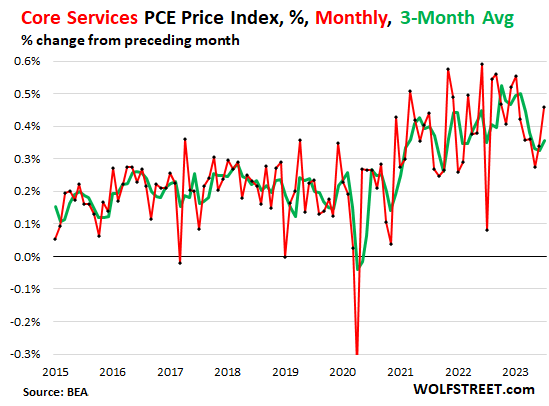
But the durable goods PCE price index plunged by 0.65% in July from June, the steepest drop since 2017, after having declined by 0.31% in June, with all four major categories declining, as some of the ridiculous price spikes, particularly for motor vehicles, have been partially unwinding since mid-2022.
- Motor vehicles, which dominate the index: -0.65%
- Furnishings and durable household goods: -0.23%
- Recreational goods and vehicles: -1.11%.
- “Other” durable goods: -0.37%
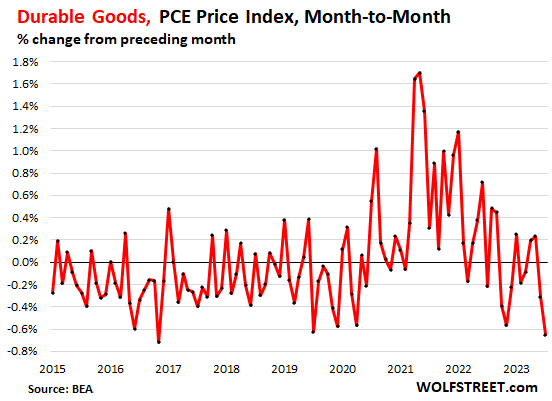
Year-over-year, the PCE price index for durable goods fell by 0.8%. The index was negative in the years before the pandemic as a result of manufacturing efficiencies, offshoring, competition, and the infamous hedonic quality adjustments that remove the costs of improvements from the cost base, on the principle that consumer price inflation is the change in dollars to buy the same product over time, and cost increases due to improvements are not inflation. Here is my explanation of hedonic quality adjustments, including my chart of prices of the F-150 XLT, the Camry LE, against the new vehicle CPI, to demonstrate the perverse effects of these adjustments.
The durable goods PCE price index is now normalizing. Absolute prices of durable goods remain high but are giving up some of the ridiculous price spikes of 2021 that had been caused when an overstimulated consumer ran into supply disruptions and was willing to pay whatever:
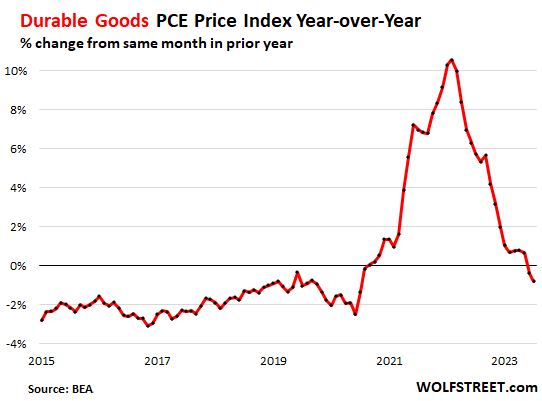
The core PCE price index, which excludes food and energy products, was revised higher for June month-to-month (was 0.17%, now is 0.21%) and accelerated from there in July to 0.22%, on the mix of the surge of the core services index (+0.46%) and the plunge in the durable goods index (-0.65%):
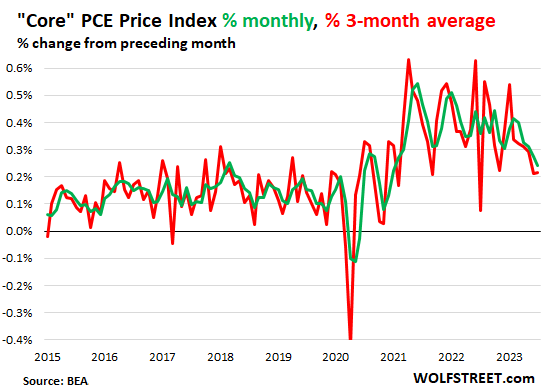
Year-over-year, the “core” PCE price index, the inflation measure favored by the Fed, accelerated to 4.2%, from 4.1% in June, over double the Fed’s target of 2%, and going in the wrong direction (red line).
The overall PCE price index accelerated to 3.3% year-over-year, pulled down by the 22% year-over-year plunge in energy prices (now abating), which caused the overall PCE price index (green) to remain below the core PCE price index (red) for the fifth month in a row. And both are going in the wrong direction.
